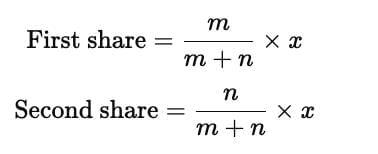Class 8 Exam > Class 8 Notes > Mathematics Class 8- New NCERT (Ganita Prakash) > Important Formula: Proportional Reasoning-1
Important Formula: Proportional Reasoning-1 | Mathematics Class 8- New NCERT (Ganita Prakash) PDF Download
| Table of contents |

|
| Proportional Change |

|
| Ratios |

|
| Proportion |

|
| Rule of Three (Trairasika) |

|
| Sharing in a Given Ratio |

|
| Unit Conversions |

|
Proportional Change
If width factor = height factor, shape remains similar.
If width factor ≠ height factor, shape becomes distorted.

Ratios
- General form:

- Simplest form of ratio:

Proportion
Two ratios are proportional if:

Condition:
 or
or
Rule of Three (Trairasika)
If three quantities are known and the fourth is to be found:

Sharing in a Given Ratio
To divide a quantity x in the ratio m:n
Unit Conversions
Length
1 metre = 3.281 feet
Area
1 square metre = 10.764 square feet
1 acre = 43,560 square feet
1 hectare = 10,000 square metres = 2.471 acres
Volume
1 millilitre = 1 cubic centimetre
1 litre = 1000 millilitres = 1000 cubic centimetres
Temperature
Fahrenheit = (9/5 × Celsius) + 32
Celsius = (5/9) × (Fahrenheit – 32)
The document Important Formula: Proportional Reasoning-1 | Mathematics Class 8- New NCERT (Ganita Prakash) is a part of the Class 8 Course Mathematics Class 8- New NCERT (Ganita Prakash).
All you need of Class 8 at this link: Class 8
|
20 videos|139 docs|11 tests
|
FAQs on Important Formula: Proportional Reasoning-1 - Mathematics Class 8- New NCERT (Ganita Prakash)
| 1. What is proportional change, and how can it be calculated? |  |
Ans.Proportional change refers to the change in a quantity relative to its original value, often expressed as a percentage. To calculate proportional change, you can use the formula: Proportional Change = (New Value - Original Value) / Original Value × 100%. This gives you the percentage increase or decrease from the original value.
| 2. How do ratios work, and what are their practical applications? |  |
Ans.Ratios are a way to compare two quantities by division, indicating how many times one value contains or is contained within the other. They are expressed in the form of a:b or a/b. Ratios are commonly used in various fields, including cooking (to mix ingredients), finance (to analyze investments), and statistics (to understand data relationships).
| 3. What is a proportion, and how is it different from a ratio? |  |
Ans.A proportion is an equation that states that two ratios are equal. For example, if a/b = c/d, then a, b, c, and d are in proportion. The key difference is that a ratio compares two quantities, while a proportion asserts the equality of two ratios. Proportions are useful in solving problems involving scaling and comparisons.
| 4. What is the Rule of Three (Trairasika), and when is it used? |  |
Ans.The Rule of Three, or Trairasika, is a mathematical principle used to find a fourth value when three values are known, and they are in proportion. It is commonly applied in problems involving direct or inverse variation. For example, if a/b = c/d, you can find d by rearranging the equation to d = (b × c) / a.
| 5. How do you share a quantity in a given ratio? |  |
Ans.To share a quantity in a given ratio, first, determine the total number of parts in the ratio. Then, divide the total quantity by the total parts to find the value of one part. Finally, multiply the value of one part by each part of the ratio to allocate the quantities accordingly. For example, for a ratio of 2:3 sharing a total of 50 units, each part is 10 units, resulting in 20 units for the first and 30 units for the second.
Related Searches















